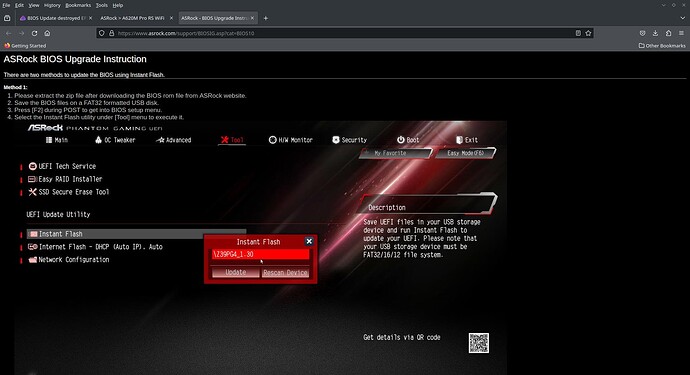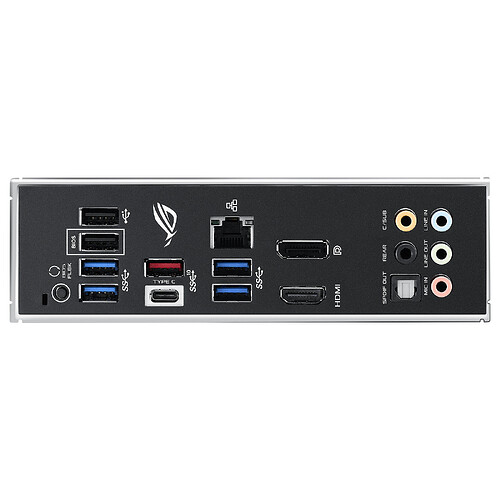A620M Pro RS WiFi, wasnt my first choice…but my BF buy turned out to be bad and had to be returned, and they were out of stock on that model, etc.
UEFI Bios update should be straight forward using instant flash. Not sure why you would have an issue with it. ![]()
Rick, it didn’t work. It would not find the flash ROM. I finally had to use the flashback powered off method (plugging into a certain USB on the backplane, and pressing the flashback button).
The powered on BIOS tool still doesn’t see any files.
I’m trying to harass the tech support about why…but his answers typically are one liners.
It’s strange because I have been doing firmware and Bios updates for many years. Although there are a few methods to accomplish the task i always use the same method and I’ve never had an issue or a failure. Did you extract the actual file first after downloading it and then copy it to a properly formatted fat32 drive? I’ve never used the flashback button. I always boot the computer and enter the UEFI set up screen and run the flash utility from there. ![]()
Ditto Rick…that’s why I report it as ‘strange’.
I remember (seems) running utilities in Windows to flash too.
However…
from my experience some motherboards needs to use a specified usb port to be able to use the usb for buiis flashing, and in addition some needs to have a certain filename without different from the one from the download.
On gigabyte the want it named gigabyte.bin and they call it q-flash with an usb port marked red with q-flas written under it…
Yep, there is no mention of needing to use a specific USB port other than for the cold flash that I did. Even using that the UEFI tool couldn’t find anything.
However, i went ahead and flashed via the powered off mode to 2.02 and it worked…but it lost the same set of stuff as the 1.24 BIOS update.
So…I need to recover the linux boot manager yet again.
Addition:
I think i have decided that part of the perceived problem is this cold flashback procedure is intended for recovery when you’ve bricked the BIOS. So it intentionally clears everything out. Makes sense, just annoying that the normal mode doesn’t seem to work for m.
The instant flash is probably my favorite accidental thing about my ASRock board from my build a couple months. It’s so simple. I’ve done 2 updates so far. Neither bumped my boot loader, although I did need to re optimize my ram both times.
If instant flash isn’t working on your hardware and it’s still under warranty, I’d exchange that now. That’s a serious defect.
Fyi I have B550 Steel legend.
Edit: mine I don’t need a specific port, although that may have changed. Make sure you format and set up the USB correctly, as it’s very specific and will not work if not done correctly.
Ive never used a specific port either on any of my boards. I just use M flash or EZ flash from the UEFI settings screen. I have done 14 updates on both boards over the time Ive had them.
You don’t need to access the bios settings with this method, the motherboard must be powered, that’s all.
On the back plane, there’s a specific USB port and an update button.
edit
See on the left :
Yes I know this… What i said was that i have never used that method ever on any system. Newer motherboards have this but i don’t use it. I always use the flash utility from the firmware settings on newer boards. It also allows you to do it live from online rather than downloading the files and putting them on usb. I don’t usually use this method but i have on occasion.
I had the opportunity to use it with my new board couple weeks ago, but had to rename the bios file with a Windows utility, I ended with the usual method. ![]()
Not sure what you are saying. ![]() Which method are you referring to? Also on my motherboards I’ve never had to rename the file. I don’t run an exe from Windows. I just extract the new file after downloading it and copy the file onto a usb drive. Boot into firmware settings and use M-flash or EZ flash to update to the new bios version. Like i said you can also update it from the network in the mflash utility in the firmware (Bios) settings. I don’t typically use that method but i have tried it.
Which method are you referring to? Also on my motherboards I’ve never had to rename the file. I don’t run an exe from Windows. I just extract the new file after downloading it and copy the file onto a usb drive. Boot into firmware settings and use M-flash or EZ flash to update to the new bios version. Like i said you can also update it from the network in the mflash utility in the firmware (Bios) settings. I don’t typically use that method but i have tried it.
You download the bios file on a USB key, plug the key to the USB specific port and push the update button.
But for this method to work with my Asus motherboard, I have to rename the file with a Windows tool.
I never had to rename the bios file when using a flash tool, even on my new board.
Okay I understand. I don’t know what the file name is when you download it or the reason why it has to be renamed. Never ever had to do this on any hardware I’ve ever owned. ![]()
Yes, from a coding perspective it does seem hokey/lazy (requiring certain name).
Yea this is also what I had to do at the time. Really odd. I didn’t use the bios flash button since Im under the impression that is a last ditch way to “save” a motherboard if you were to fail to properly update the BIOS like if there happened to be a power outage or something.
People will go to the mats to say that updating your bios won’t mess up EFI partitions but it definitely happens. Even in the best case scenarios where Linux and Windows are on separate partitions. Even in this thread you have people saying “nuh uh, cant happen. skill issue” which is just unhelpful and incorrect. The motherboard deletes those boot entries and then windows jumps in and tries to “fix” the issue which can cause some more odd issues.
Ultimately the way to fix it is to chroot into the old partition and to reinstall the boot entries. Even just running an update usually fixes everything.
I have had it happen on certain motherboards also with grub bootloader and dual boot Windows. It can happen and does occasionally. Hasn’t happened on any of the hardware i own currently but i have come across it updating UEFI Bios on some other users equipment which is usually the time you don’t want to have the issue even more. ![]()




